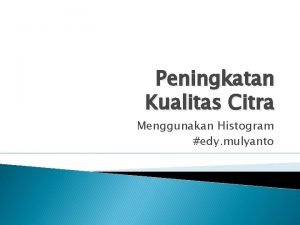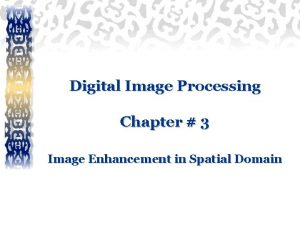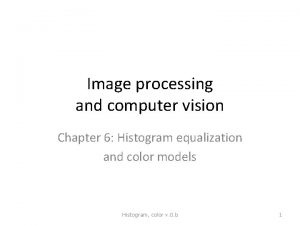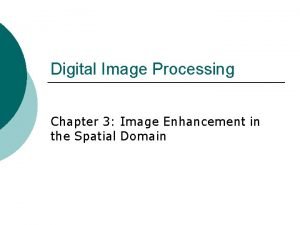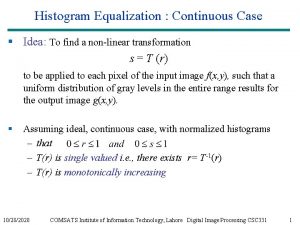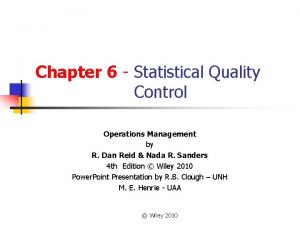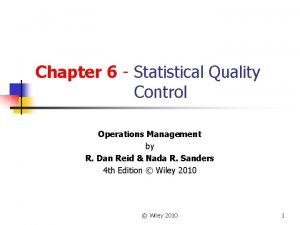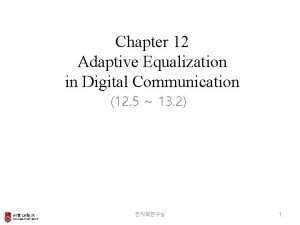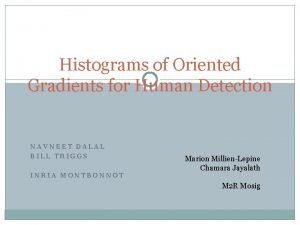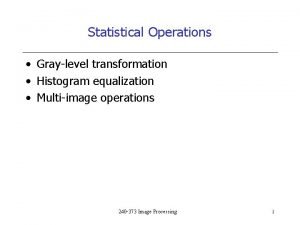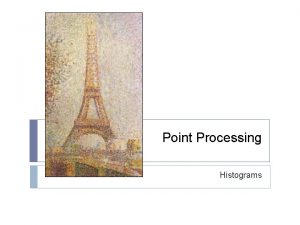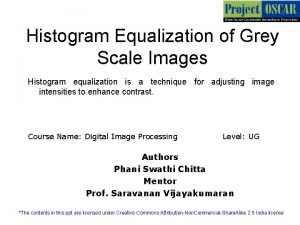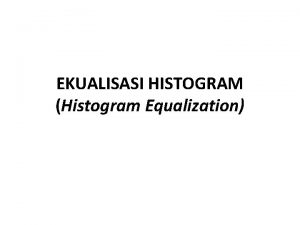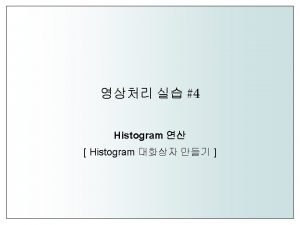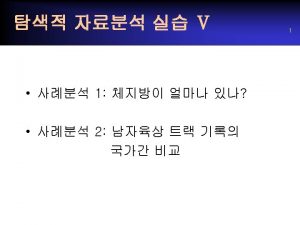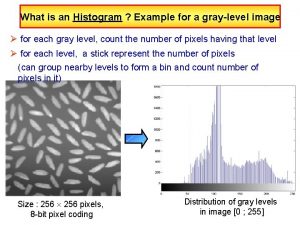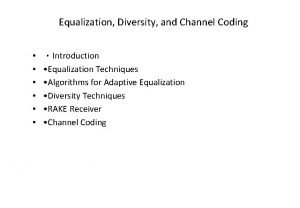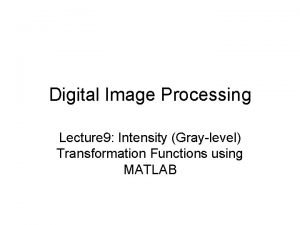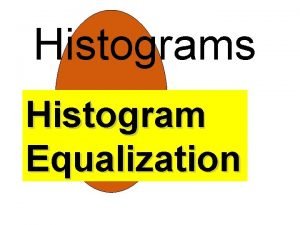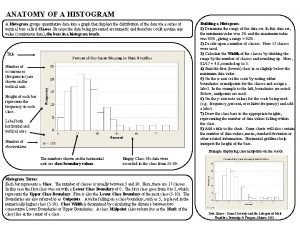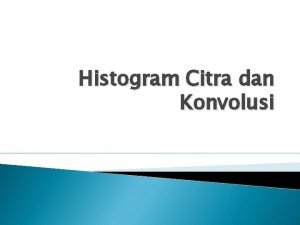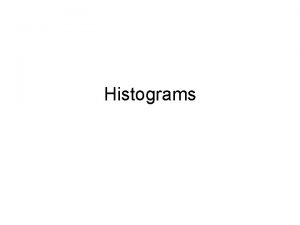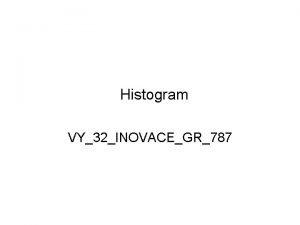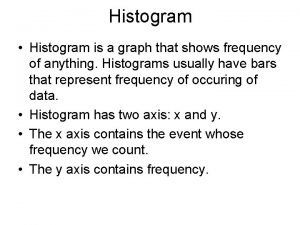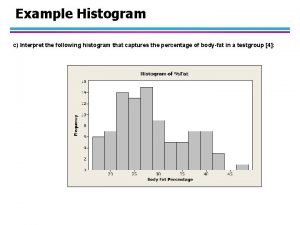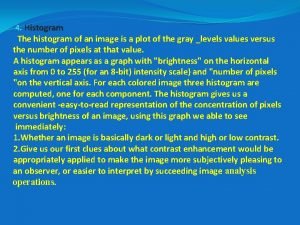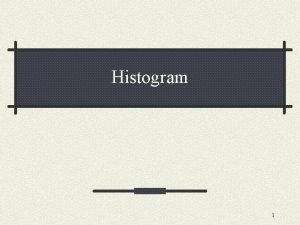Statistical Operations Graylevel transformation Histogram equalization Multiimage operations

















![Bunching Code for (row=0; row<rowmax; row(++ for (col=0; col<colmax; col(++ } image[row, col] = Bunching Code for (row=0; row<rowmax; row(++ for (col=0; col<colmax; col(++ } image[row, col] =](https://slidetodoc.com/presentation_image_h2/de1b4a45a6628379a33392b30d54b9b6/image-18.jpg)






- Slides: 24

Statistical Operations • Gray-level transformation • Histogram equalization • Multi-image operations 240 -373 Image Processing 1

Histogram • If the number of pixels at each gray level in an image is counted (may use the following code fragment( for (row=0; row<rowmax; roww(++ for (col=0; col=colmax; col(++ } count[image[row, col; ++[[ { 240 -373 Image Processing 2

Histogram • The array “count” can be plotted to represent a “histogram” of the image as the number of pixels at particular gray level • The histogram can yield useful information about the nature of the image. An image may be too bright or too dark. 240 -373 Image Processing 3

Histogram Illustration Histogram 10 2 4 1 2 0 3 1 2 1 4 2 2 1 3 1 2 2 0 4 2 4 1 0 4 1 5 9 8 7 6 5 4 3 2 1 0 0 1 2 240 -373 Image Processing 3 4 5 4

Global Attenuation in Brightness • To alter the brightness of an image by adding or subtracting all pixel values with a constant for (row=0; row<rowmax; roww(++ for (col=0; col=colmax; col(++ } image[row, col] += constant; { 240 -373 Image Processing 5

240 -373 Image Processing 6

240 -373 Image Processing 7

240 -373 Image Processing 8

240 -373 Image Processing 9

Thresholding • Use : – To remove the gray level trends in an image – To make gray level more discrete – To segment or split an image into distinct parts • Operation: – setting all gray levels below a certain level to “zero”, and above a certain level to a maximum brightness 240 -373 Image Processing 10

Code for Thresholding for (row=0; row<rowmax; roww(++ for (col=0; col=colmax; col(++ } if (image[row, col] > threshold( image[row, col] = MAX; else image[row, col] = MIN; { 240 -373 Image Processing 11

240 -373 Image Processing 12

Thresholding Errors • Rarely is it possible to identify a perfect gray level break, what we want to be background pixels become foreground or vice versa – Type 1: not all pixels caught that should be included – Type 2: some pixels caught should not be included in the group 240 -373 Image Processing 13

An image before and after thresholding 240 -373 Image Processing 14

Bunching (Quantizing( • Use: – to reduce the number of different gray level in an image – to segment an image – to remove unwanted gray level degradation • Operation: – Close gray levels are combined, thus removing unwanted variations in data 240 -373 Image Processing 15

Bunching (Quantizing( • Method 1: inspecting histogram and combining close group into single gray level • Method 2: identifying a set of gray levels allowed in the final image, then changing the gray level in every pixel to its nearest allowed value 240 -373 Image Processing 16

Bunching Example **** 0 ** 1 ***** 2 ***** 3 ***** 4 ***** 5 ***** 6 ***** 7 ***** 8 *** 9 240 -373 Image Processing ****** 0 1 2 ********** 3 4 5 ******** 6 7 8 ****** 9 17
![Bunching Code for row0 rowrowmax row for col0 colcolmax col imagerow col Bunching Code for (row=0; row<rowmax; row(++ for (col=0; col<colmax; col(++ } image[row, col] =](https://slidetodoc.com/presentation_image_h2/de1b4a45a6628379a33392b30d54b9b6/image-18.jpg)
Bunching Code for (row=0; row<rowmax; row(++ for (col=0; col<colmax; col(++ } image[row, col] = bunchsize*((int)image[row, col]/bunchsize; ( { bunchsize = number of levels to be grouped into one 240 -373 Image Processing 18

Splittings • Use: – to increase the different two groups of gray levels so that the contrast between segments compose of one group of the other is enhanced • Operation: – rounding the gray levels up if they are in the range and down if they are in another 240 -373 Image Processing 19

Splitting Example • The characters on a car number-plate are at gray level 98 • The background of the characters is at gray level 99 • Pushing 98 down to 80 and pushing 99 up to 120 will give the picture a better contrast around the number plate Question: How to find a good splitting level? 240 -373 Image Processing 20

Automatic Selection of Splitting Level • Use: – to find the best gray level for splitting--usually for thresholding to black and white • Operation: – Let 240 -373 Image Processing 21

Automatic Selection of Splitting Level – Let P=Nx. M = the number of pixels under consideration m(g) = mean gray level for only those pixels containing gray level between zero and g, i. e. If the maximum number of gray level is G (G=0, …, G-1) then evaluate the following equation (T = splitting threshold( A Processing 240 -373 Image B 22

Example Histogram f(g) t(g) g. f(g) 4**** 0 4 0 1 ** 2 6 2 2 ***** 5 11 10 3 ***** 9 20 27 4 ***** 5 25 20 5 ***** 5 30 25 4. 642. 252. 063. 311430355***** 6 4. 031. 213. 333. 714935405***** 7 1. 470. 0916. 334. 522172499***** -4. 824827523*** 9 Sg. f(g) m(g) 0 2 12 39 59 84 0 0. 3 1. 1 2 2. 4 2. 8 A B A*B 0. 08 0. 13 0. 27 0. 63 0. 93 1. 36 23. 04 20. 25 13. 69 7. 84 5. 76 4. 00 0. 18 2. 83 3. 70 4. 94 5. 36 5. 44 8 T = max(A*B) - 1 = 4 240 -373 Image Processing INF 23

240 -373 Image Processing 24
 Contoh perhitungan histogram citra
Contoh perhitungan histogram citra Noise removal
Noise removal Histogram equalization
Histogram equalization Histogram equalization
Histogram equalization Histogram equalisation in image processing
Histogram equalisation in image processing Digital image processing
Digital image processing Statistical quality control in operations management
Statistical quality control in operations management Operations management quality control
Operations management quality control Petroleum equalisation fund (management) board
Petroleum equalisation fund (management) board Aquila
Aquila It is the visual equalization of the elements of art
It is the visual equalization of the elements of art “pro-death” is a loaded phrase.
“pro-death” is a loaded phrase. Adaptive equalization in digital communication
Adaptive equalization in digital communication Gw2 equalization protocol
Gw2 equalization protocol Refers to the equalization of elements in a work of art
Refers to the equalization of elements in a work of art A1 flow equalization basin
A1 flow equalization basin Headphone equalization
Headphone equalization Tripod configuration in rpd
Tripod configuration in rpd Petroleum equalization fund
Petroleum equalization fund Quadrilateral configuration rpd
Quadrilateral configuration rpd Equalization rhetorical device
Equalization rhetorical device Operation transformation process
Operation transformation process The transformation model operations management
The transformation model operations management Operations management transformation process
Operations management transformation process Histograms of oriented gradients for human detection
Histograms of oriented gradients for human detection
